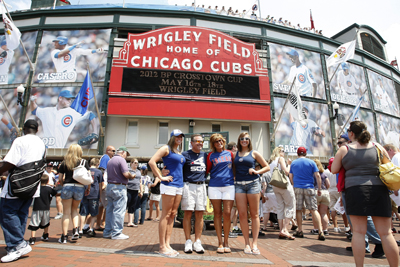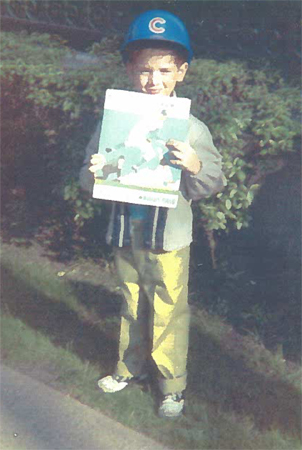Tom Ricketts
Cubs chairman
“I grew up in Omaha, Neb. My first game at Wrigley, I was going into my senior year in high school. I was in town that summer with a group of people, and it was a beautiful Saturday afternoon. I just remember, ‘This is a really special place.’ Years later, when I came here for college and then moved to the North Side, we went to as many games as we could and sat in the bleachers almost exclusively. My brother Pete slept outside for tickets [the night before single-game sales before the season]. We lived across the street above the Sports Corner bar, literally 100 feet from the [ballpark] door. Went to a lot of games, always sat in the bleachers. I made a lot of friends out there and met my wife in the bleachers.”
Ed Hartig
Cubs historian, writer for Vine Line, the team’s fan magazine
“I come from a family of White Sox fans on the South Side, the fifth of six children. When my elder sister and brothers were at school, I was at home. Every Cubs home game was on WGN. At 1 p.m., I would sit down, my mom would bring me lunch, and I would watch the Cubs games. I grew up with [Cubs broadcasters] Jack Brickhouse and Jim West. [My first game was] July 1970. I kept begging my parents to go. Both were South Siders too but weren’t anti-Cubs like my siblings. Finally my mom convinced my dad, ‘Take him.’ It was a Friday, which was Ladies Day. The Cubs beat the Braves big, 11-0 or 11-1. My favorite player was Billy Williams, and he hit a homer [and] that sort of sealed it right there. I can still remember coming up from behind home plate and seeing all the green and the people. I was 5, so a crowd of 35,000 to me was a like a million people. It was packed, full color, big scoreboard, ivy in full bloom.”
 |
The famous red marquee serves as the backdrop for many visitors who make the pilgrimage to Wrigley Field.
Photo by: Getty Images |
Colin Faulkner
Cubs vice president of sales and partnerships
“I grew up in Boulder, Colo. I had never been to Wrigley until I came up for my [job] interview. Before I went into the park, I took a lap around the block, which I think is something a lot of people do just to see all that’s going on in the neighborhood and the activity around game day. It was surreal because in your mind, it’s maybe really big, but in reality, it’s such a small footprint and there is so much to take in. In my mind, I built Wrigley up as
{podcast}
SBJ Podcast:
MLB writer Eric Fisher and facilities reporter Don Muret on Wrigley Field's first 100 years, what the park means to Chicago and what its future holds
this once-in-a-lifetime baseball cathedral that was unique. It lives up to that expectation when you walk in. It’s just special.”
Jed Hoyer
Cubs executive vice president and general manager
“My first time at Wrigley was in 1988. I grew up in New Hampshire, and my mom had a really good friend who was a huge baseball fan. I was 11 or 12 and did fantasy league; all adults and me. I would score by hand going through The Sporting News. She took me on a trip to Wrigley, Comiskey, County Stadium, Detroit and Cleveland, all those parks in a seven- or eight-day span. [Wrigley] had just got lights, but I don’t remember if it was a day or night game. That summer I was 14 years old. Lot of fun.”
Pat Hughes
Cubs broadcaster
“My first game at Wrigley was in the early ’80s, preseason, Cubs against Milwaukee [when Hughes worked for the Brewers]. I don’t remember the details. It was a freezing cold late March/early April day, but the atmosphere was what struck me: the ambience, the proximity of the fans to the field. The noise, even for an exhibition game, was overwhelming — the thunderous roar from the crowd. That’s what struck me, the loudness of the ballpark. My first game working for the Cubs was in 1996 against San Diego. It was 32 degrees, bright and sunny, clear as a bell but freezing cold. The wind chill I think was about 18 at game time. The pitchers were Jaime Navarro for the Cubs and Alan Ashby for the Padres — two hard throwers, and in those conditions it looked like each guy was throwing 120 mph. It was a low-scoring game, and the Cubs did win in extra innings on a Mark Grace base hit to left field to drive in the winning run.”
Andrew Belleson
Wrigley Field public address announcer
“I was 9 and it was in 1996. The Cubs were playing the Cardinals. I wanted to see [Cardinals outfielder] Willie McGee bat. I don’t recall if the Cubs won or lost, but I was a huge Harry Caray fan, and where we were sitting, if we couldn’t see the press box, I would always ask my parents to take me [to a section] so we could see the front of it when he sang the seventh-inning stretch. I had to see him sing the stretch.”
Crane Kenney
Cubs president of business operations
“My first trip to Wrigley I was a freshman or sophomore at Notre Dame. I was born in Quincy, Mass., and we moved to Michigan when I was an undergrad. I hadn’t been to Chicago. A group of us drove in from South Bend and sat in the upper deck. First inning, one of our friends caught a foul ball. I thought, ‘This place is awesome.’ Having gone to Fenway, it felt familiar. Small footprint, all the same characteristics: proximity to the field, tight space, a lot of energy in the park and the neighborhood.”
Todd Ricketts
Cubs board of directors
“The first Cubs game I went to was in 1989. I don’t think I’ve ever sat outside the bleachers. We were pretty dedicated to the bleachers as fans in our younger days. There were a couple of summers when I went to games by myself. I used to show up early on Sunday, get a newspaper, and go in when the gates opened at 11:20. I would get an Old Style or a Pepsi sometimes, sit in the second row right off the aisle on the center field bleachers, read my newspaper, and watch batting practice. That was my favorite thing to do. It was quiet at that time; really a peaceful place.”
Mike Lufrano
 |
Lufrano on his first visit to Wrigley Field.
|
Cubs executive vice president of community affairs and general counsel
“I grew up just east of the ballpark. Between the age of 4 and 9, I would do every birthday [in July] at the ballpark. Like so many of our fans, I have these great memories of growing up and going to Wrigley with my dad and my grandfather [and] going to the game after the seventh inning when they opened up the gates and we got out of school at 3 p.m. If you told me I could have worked for the team at the time … I would have said you were joking. My dream was to play shortstop.”
Gary Pressy
Cubs organist
“I grew up in Chicago and went to my first game at Wrigley in 1964. It was against the Reds, and Pete Rose broke up Larry Jackson’s bid for a no-hitter with a base hit in the seventh inning. I think the Cubs still won that game. I was 6 1/2. One of my most memorable moments as a fan at Wrigley was June 22, 1969. The Cubs were playing a doubleheader with Montreal, and [Cubs outfielder] Jimmy Hickman hit a home run in the ninth inning to win the game. We were sitting down the left-field line, and suddenly we see [Cubs third baseman] Ron Santo jumping up and down. That actually was the first time he clicked his heels.”
Ernie Banks
Former Cubs shortstop/first baseman and baseball hall of famer
“When I walked in here in 1953, I looked up at the vines. I was thinking of Peggy Lee. She sang that song “Is That All There Is?” My friends in Kansas City [in the Negro Leagues] had talked about me going to the major leagues. I didn’t know what it was. [Wrigley] was impressive to me, but it was not the end of the world, just another place to play. But as I met a lot of the fans, they were like family to me. You’re close to the fans, they’re close to you — you could just look in their eyes and feel how they felt. It was exciting to the point where I wanted to get a camera and take pictures of the faces of people that come to Wrigley Field and how they react. That’s amazing to me.”
Carl Rice
Cubs vice president of ballpark operations
“I grew up in Chicago, a North Sider; went to St. Benedict High School, right down the street from Wrigley. I remember one of the first games I went to as a fan. The Cubs were playing the Expos, and I sat in a lower field box with a friend. The game got suspended due to darkness. It’s amazing now that I control that part of it [with lights]. It’s kind of funny: Back when I started [part-time] in 1982, I used to leave school, ride my bike, and chain it up in the concourse. They used to have only 4,000 people going to games back then. It was a whole different thing. People talk about the upper deck being shut down. I was there during those days. My first day working for the Cubs, they just came out of the lockout and were supposed to play the White Sox in an exhibition. It got snowed out. It was Easter Sunday. I got handed cash and an Easter lily and they said, ‘Thank you for your time.’ I gave my mom the Easter lily.”
Billy Williams
Former Cubs outfielder and baseball hall of famer
“Right field in Wrigley at that time was one of the toughest fields to play because it was a sun field. Before they built the stadium boxes, the sun used to shine right in your face, so you had to either play out of position on the right or on the left. You couldn’t line the hitter up with the sun, and many times you had to go to one side or the other. A lot of right fielders came into Wrigley — some of the best in baseball — and they had a lot of trouble. Nobody wanted to play it because you had to deal with the sun.”





